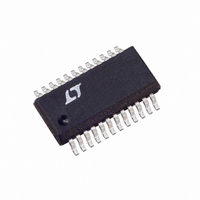LTC1436AIGN-PLL#TR Linear Technology, LTC1436AIGN-PLL#TR Datasheet - Page 14

LTC1436AIGN-PLL#TR
Manufacturer Part Number
LTC1436AIGN-PLL#TR
Description
IC REG SW SYNC STEPDWN LN 24SSOP
Manufacturer
Linear Technology
Type
Step-Down (Buck)r
Datasheet
1.LTC1436AIGN-PLLPBF.pdf
(28 pages)
Specifications of LTC1436AIGN-PLL#TR
Internal Switch(s)
No
Synchronous Rectifier
Yes
Number Of Outputs
1
Voltage - Output
1.19 ~ 9 V
Current - Output
50mA
Frequency - Switching
125kHz ~ 240kHz
Voltage - Input
3.5 ~ 30 V
Operating Temperature
-40°C ~ 85°C
Mounting Type
Surface Mount
Package / Case
24-SSOP
Lead Free Status / RoHS Status
Contains lead / RoHS non-compliant
Power - Output
-
Other names
LTC1436AIGN-PLLTR
Available stocks
Company
Part Number
Manufacturer
Quantity
Price
Part Number:
LTC1436AIGN-PLL#TRLTC1436AIGN-PLL
Manufacturer:
Linear Technology
Quantity:
135
APPLICATIONS
LTC1436A
LTC1436-PLL-A/LTC1437A
where δ is the temperature dependency of R
is a constant inversely related to the gate drive current.
Both MOSFETs have I
N-channel equation includes an additional term for transi-
tion losses, which are highest at high input voltages. For
V
with larger MOSFETs, while for V
losses rapidly increase to the point that the use of a higher
R
efficiency. The synchronous MOSFET losses are greatest
at high input voltage or during a short circuit when the
duty cycle in this switch is nearly 100%. Refer to the
Foldback Current Limiting section for further applications
information.
The term (1 + δ ) is generally given for a MOSFET in the
form of a normalized R
δ = 0.005/°C can be used as an approximation for low
voltage MOSFETs. C
characteristics. The constant k = 2.5 can be used to
estimate the contributions of the two terms in the main
switch dissipation equation.
The Schottky diode D1 shown in Figure 1 serves two
purposes. During continuous synchronous operation, D1
conducts during the dead-time between the conduction of
the two large power MOSFETs. This prevents the body
diode of the bottom MOSFET from turning on and storing
charge during the dead-time, which could cost as much as
1% in efficiency. During low current operation, D1 oper-
ates in conjunction with the small top MOSFET to provide
an efficient low current output stage. A 1A Schottky is
generally a good compromise for both regions of opera-
tion due to the relatively small average current.
C
In continuous mode, the source current of the top
N-channel MOSFET is a square wave of duty cycle V
V
capacitor sized for the maximum RMS current must be
used. The maximum RMS capacitor current is given by:
14
IN
IN
IN
DS(ON)
C
. To prevent large voltage transients, a low ESR input
< 20V the high current efficiency generally improves
and C
IN
Required I
device with lower C
OUT
Selection
RMS
U
RSS
≈
DS(ON)
is usually specified in the MOSFET
I
INFORMATION
MAX
2
U
R losses while the topside
RSS
[
V
vs temperature curve, but
OUT
actual provides higher
IN
(
W
V
> 20V the transition
IN
V
−
IN
V
OUT
DS(ON)
)
U
]
1 2
/
and k
OUT
/
This formula has a maximum at V
I
monly used for design because even significant deviations
do not offer much relief. Note that capacitor manufacturer’s
ripple current ratings are often based on only 2000 hours
of life. This makes it advisable to further derate the
capacitor, or to choose a capacitor rated at a higher
temperature than required. Several capacitors may also be
paralleled to meet size or height requirements in the
design. Always consult the manufacturer if there is any
question.
The selection of C
series resistance (ESR). Typically, once the ESR require-
ment is satisified, the capacitance is adequate for filtering.
The output ripple (∆V
where f = operating frequency, C
and ∆I
is highest at maximum input voltage since ∆I
with input voltage. With ∆I
ripple will be less than 100mV at maximum V
Manufacturers such as Nichicon, United Chemicon and
Sanyo should be considered for high performance through-
hole capacitors. The OS-CON semiconductor dielectric
capacitor available from Sanyo has the lowest ESR (size)
product of any aluminum electrolytic at a somewhat
higher price. Once the ESR requirement for C
met, the RMS current rating generally far exceeds the
I
In surface mount applications multiple capacitors may
have to be paralleled to meet the ESR or RMS current
handling requirements of the application. Aluminum elec-
trolytic and dry tantalum capacitors are both available in
surface mount configurations. In the case of tantalum, it is
critical that the capacitors are surge tested for use in
switching power supplies. An excellent choice is the AVX
TPS series of surface mount tantalums, available in case
heights ranging from 2mm to 4mm. Other capacitor types
RMS
RIPPLE(P-P)
C
∆
OUT
V
= I
OUT
L
OUT
= ripple current in the inductor. The output ripple
Required ESR < 2R
≈
/2. This simple worst-case condition is com-
requirement.
∆
I ESR
L
⎛
⎜
⎝
OUT
OUT
+
is driven by the required effective
4
) is approximated by:
fC
1
SENSE
OUT
L
= 0.4I
⎞
⎟
⎠
OUT
= output capacitance
OUT(MAX)
IN
= 2V
IN
OUT
OUT
, assuming:
L
the output
increases
has been
, where
14367afb














